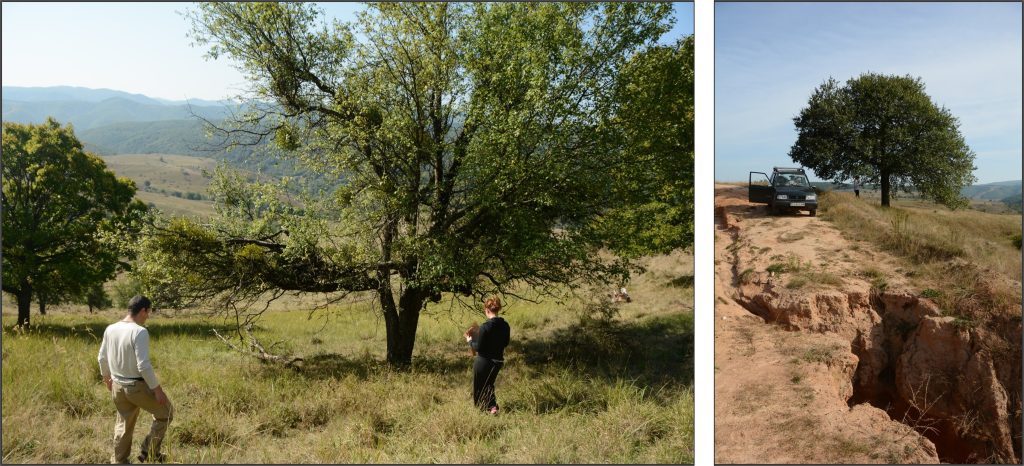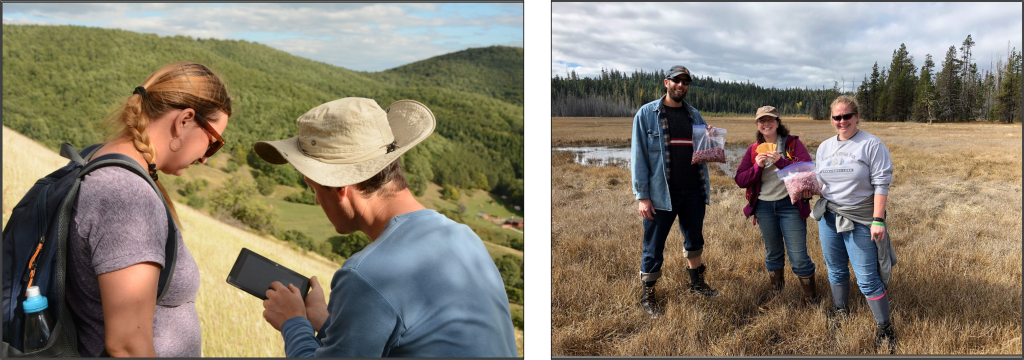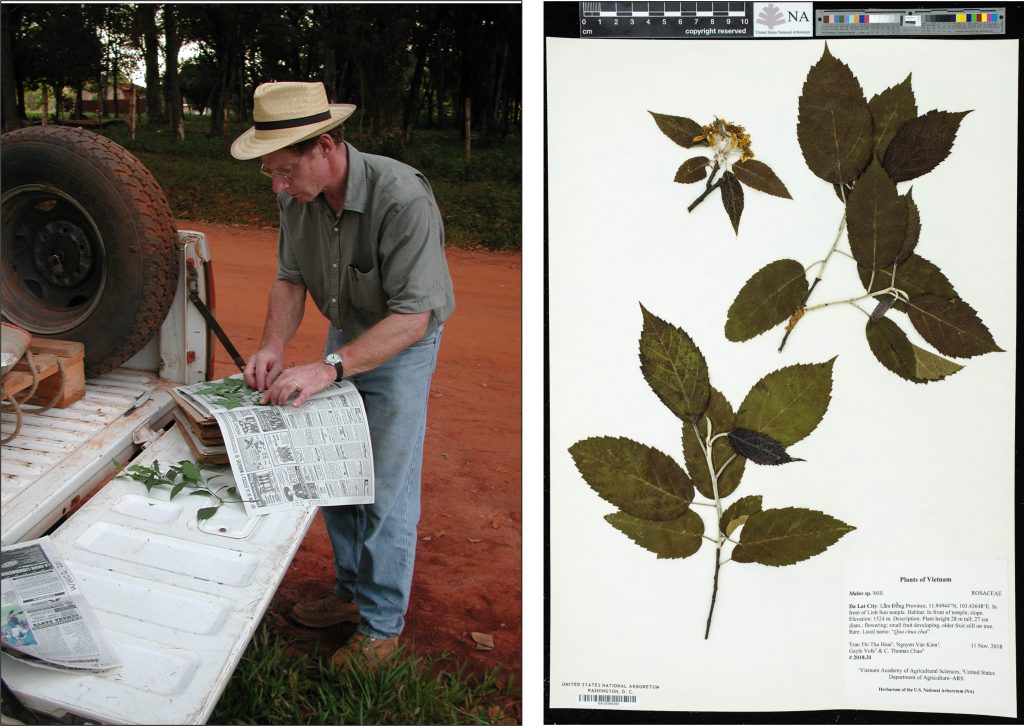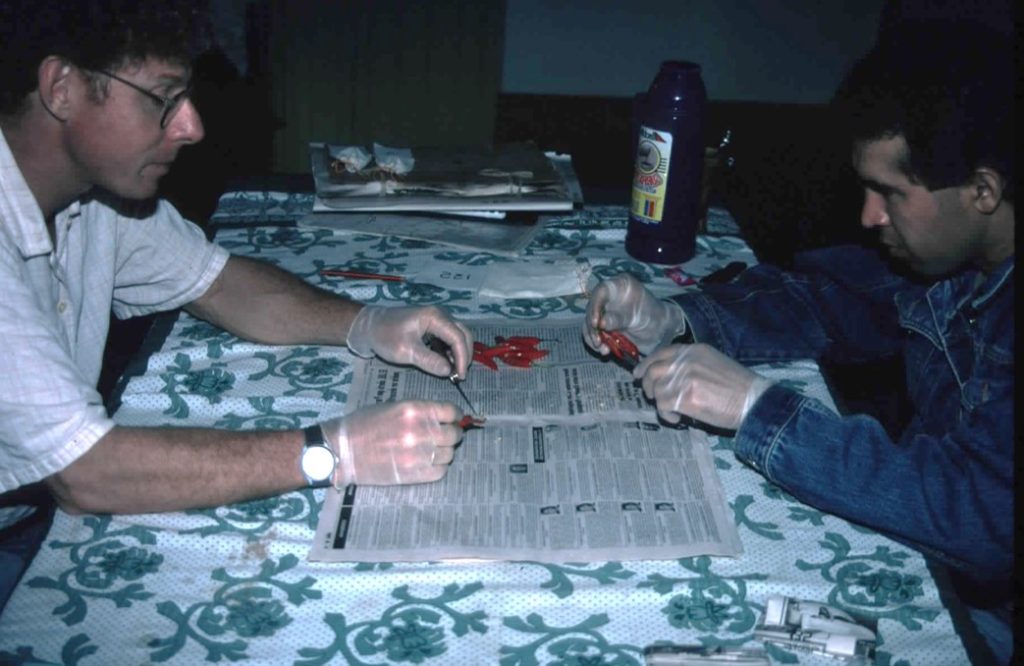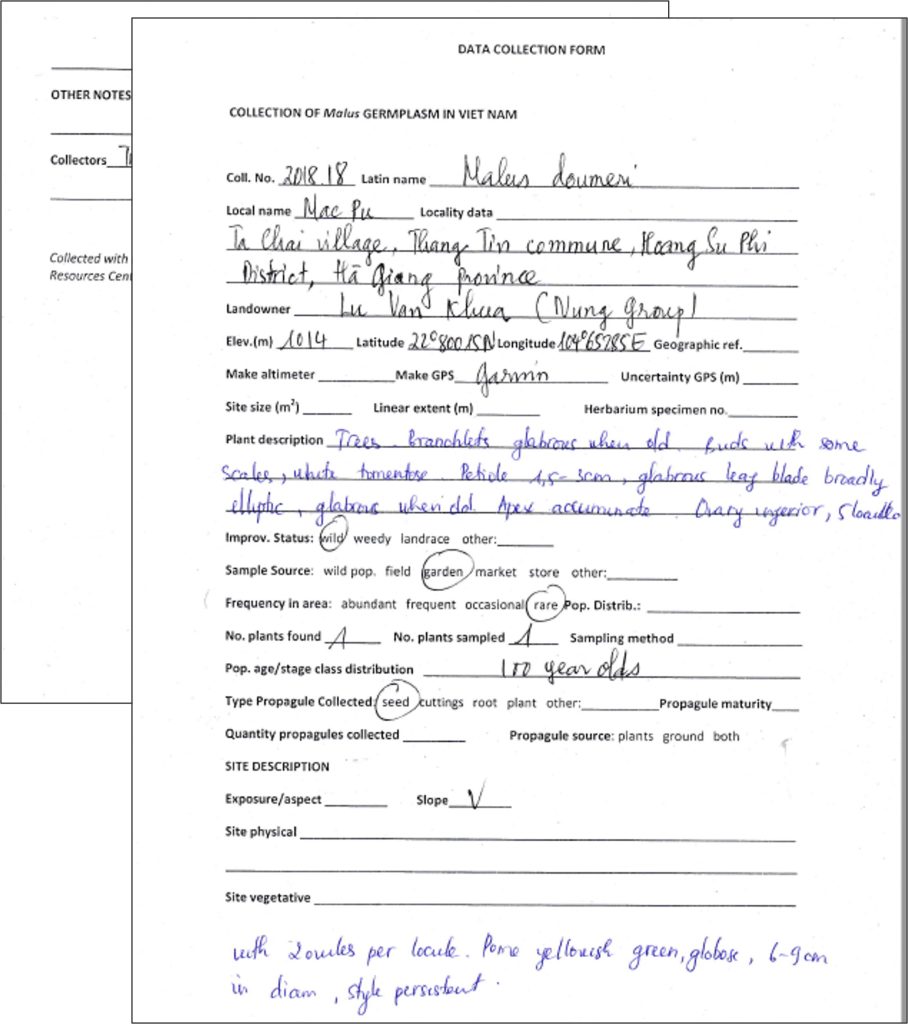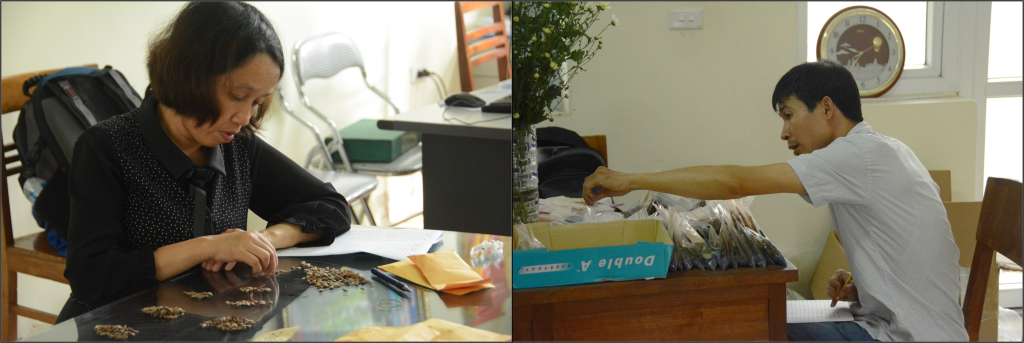Conducting an Exploration for Plant Genetic Resources to be Incorporated into the USDA National Plant Germplasm System
Karen A. Williams
Contact: Anne.Frances@usda.gov
OUTLINE
- Introduction
- Fieldwork and collecting
- Post-fieldwork
- Follow-up after explorations
- Conclusion
- References
- Additional information
- Acknowledgments
1. introduction
A successful plant exploration requires careful planning and preparation. Information about planning is available in the Fundamentals of Plant Genebanking eBook chapter titled “Planning a Plant Exploration for Plant Genetic Resources to be Incorporated into the USDA National Plant Germplasm System”. Permission to collect must be in place before the exploration begins, whether it is permission from national authorities in other countries or landowners in the United States. Even with the most carefully planned exploration, flexibility is critical as unforeseen circumstances often occur. The seed set in any given year often varies and may limit the amount that can be collected. Although the timing of seed maturation can be estimated with study of herbarium specimens and other germplasm collections, climatic variation may alter the expected pattern and even result in complete failure of fruiting. Weather may present challenges that require changes in the planned itinerary or reduce the amount of time available for sampling at each site. Changes may also be necessary because of past events that damaged transportation infrastructure, such as roads and bridges.
Figure 1. Left: Example where Malus sylvestris (tree in center) fruit-set was low, so Pyrus communis (tree on left) was also collected with permission in Romania (Credit: G. Volk). Right: Washed-out road encountered during a Romania collection exploration in 2017 (Credit: G. Volk).
2. fieldwork and collecting
When arriving at a planned collection site, the plant population should be carefully evaluated before collecting to assess its extent and structure. For seed collection, the approximate number of individuals and seed maturity will be assessed. Seeds should also be examined for possible insect damage and empty seeds before spending time making the collection. Paper or cloth bags are best for collection of seed that is mature and dry, whereas plastic bags are recommended for collecting fleshy fruits. Pre-printed labels with waterproof ink can be helpful. In wild vegetatively propagated populations, individual genotypes can often be identified by their appearance and distance between samples minimizes the chance of duplicating samples (Huaman et al., 1995).
Figure 2. Left: Tracking the route to the collection site in Romania (Credit: G. Volk). Right: Collection of wild cranberry from Camas Prairie, Mount Hood National Forest, Oregon (Credit: K.A. Williams).
2.1 Herbarium voucher specimens
In addition to being valuable records of the flora of a region, herbarium vouchers are essential for authoritative identification of any accession not definitely identified in the field or for samples that possess uncharacteristic morphological traits. They are highly recommended when there are adequate plants in a population for sampling. A description of the methods for preparing herbarium specimens may be found in “Field Techniques Used by the Missouri Botanical Garden.” Plant material selected for herbarium vouchers should be representative of the population and include flowering and/or fruiting material. At least two herbarium vouchers should be made for each accession, with additional vouchers recommended as availability of plant material allows. For a foreign exploration, a set of the herbarium vouchers should be deposited with an herbarium in the host country. Herbarium vouchers sponsored through the USDA Plant Exploration Program and brought to the United States are deposited in the U.S. National Arboretum Herbarium. Specimens of associated pests and microsymbionts, such as rhizobium nodules, are also sometimes collected and preserved.
Figure 3. Left: Preparing an herbarium voucher of wild Capsicum in the field (Credit: K.A. Williams). Right: An herbarium sheet prepared from Malus doumeri herbarium voucher materials collected in Vietnam (Credit: H. Svoboda).
2.2 SAMPLE Handling
The viability of samples in the field varies among species and type of sample. Seeds encased in fruits should be extracted as soon as possible. Damp seeds can be spread out to dry, preferably on a surface where they will not stick, either outside in the shade or in a room with good air circulation. Seed should be kept in a cool, dry place, but not frozen. Some samples may need to be refrigerated to preserve viability. Leaf samples for DNA analysis are collected for some plants and may require storage in silica gel beads.
Figure 4. Extracting seeds from Capsicum fruits in Paraguay (Credit: K.A. Williams).
2.3 documentation
Thorough documentation (passport data) of germplasm collections is vital to effective conservation and utilization. Some data will be related to the site (habitat, vegetation) and other data will be specific to the individuals collected. Multiple datasheets may be used. Complete passport data include:
- Collector number – a unique number for each sample
- Locality data (including latitude, longitude, and elevation), information about how to access the site, landowner, local name of site
- Date
- Habitat description (exposure/aspect, slope, physical description-soil, moisture, etc.)
- Associated vegetation
- Improvement status (wild, weedy, landrace, etc.)
- Source (wild population, field, garden, market, store, farmer’s storage, etc.)
- Local cultivation and uses (especially for landraces)
- Plant description
- Frequency in area (abundant, frequent, occasional, rare)
- Number of plants found
- Number of plants sampled
- Quality of plants sampled (diseases observed, health, apparent seed quality)
- Population age class distribution
- Propagule collected
- Propagule maturity
- Quantity of propagules collected
- Location of propagules (plants, ground, both)
- Herbarium voucher number
- Collectors’ names
- When relevant, documentation of permission received from landowner and/or farmer-grower to collect the plant genetic resources. This is technically termed “prior informed consent on mutually-agreed terms” (acronym: PIC-MAT).
Figure 5. Sample collection form for Malus doumeri collected in Vietnam.
Other data are appropriate for specific purposes. For example, specific characteristics such as height or circumference, may be recorded for some taxa. Information on landraces and other wild utilized plants must abide by the permission of the community and national laws (see preceding mention of PIC-MAT).
Collector numbers that are unique and combine characters and numbers assist with tracking germplasm samples after they are collected. Characters may be the collectors’ initials or an abbreviation for the country (not including the United States) in which the exploration is conducted, and numbers may refer to the year of the collection and the sample number. For example, accessions from an exploration in Canada in 2022 could be numbered as CAN2022-1, CAN2022-2, etc. Identification with unique numbers will greatly facilitate locating accessions in germplasm databases after they are deposited. All sample bags must be labeled with the collector number.
Photographs of the habitat and target plants (whole plants and individual organs (fruit, flower, seed, etc.) are valuable records and can be added to the documentation in germplasm databases.
Figure 6. Photos taken at the time of collection. Left: Habitat of wild cranberries – Big Run Bog, West Virginia (Credit: K. A. Williams). Right: Malus doumeri samples on a grid (Credit: G. Volk).
Another important part of documentation is the production of reports, which are written after the conclusion of an exploration. Reports should include trip narrative, participants, itinerary, copies of permits, catalog of collections with detailed passport data, and recommendations for subsequent explorations or other conservation activities. Photographs described above help to round out reports.
Figure 7. Documenting germplasm collected in Paraguay (Credit: K.A. Williams).
2.4 plant health
Plant explorers must take precautions to protect against accidental introduction of diseases, insects, noxious weeds, and other organisms when collected material is taken to their home country. In the United States, the USDA Animal and Plant Health Inspection Service (APHIS) regulates the entry of plant materials. All germplasm imported into the United States must be accompanied by a phytosanitary certificate issued by the National Plant Protection Organization in the country in which it was collected. This document certifies that the material meets requirements on plant health of the recipient country. Upon arriving in the United Sates, the germplasm is inspected by an APHIS Plant Protection and Quarantine (PPQ) inspector to ensure that the materials are free from exotic pests, pathogens, noxious weeds, soil, and extraneous materials. The APHIS-PPQ inspector also ensures that the material complies with all federal regulations on importing. Additional information about plant import is available in the Fundamentals of Plant Genebanking eBook chapter titled “Phytosanitary and Regulatory Issues in the Movement of Plant Genetic Resources: A U.S. Perspective“.
The “Plants for Planting” manual published by APHIS lists restrictions on importing propagative plant materials into the United States; the manual can be downloaded here. Plants designated as Not Authorized Pending Pest Risk Assessment (NAPPRA) or not authorized (prohibited) are among those that are regulated. A post entry quarantine (PEQ) permit is required for germplasm that must undergo quarantine. Seeds are exempt from post entry quarantine. A controlled import permit (CIP) is required for plants designated as NAPPRA. Plants imported under this permit are limited in use. Other types of permits may be required for plants with other restrictions. The APHIS website “Plants and Plant Products Permits” presents information on how to apply for a permit.
3. post-fieldwork
After all germplasm samples have been collected, many activities remain to ensure that the collected germplasm is conserved and available for use. Additional time is needed to extract and dry seeds. Finishing the documentation is more easily completed immediately after the collecting is completed. Herbarium samples need to be prepared with the associated documentation. For international explorations, germplasm samples should be divided between the host institution and the visiting collectors. Careful cleaning of plant material helps to ensure that it will be acceptable to inspectors if sent to another country. If germplasm is to be sent to the United States, a phytosanitary certificate must be issued by the National Plant Protection Organization in the country in which it was collected. The germplasm must be packaged along with a list of samples and passport data, the phytosanitary certificate, and an import permit from APHIS in the United States. The package is then sent to an USDA Animal Plant Health Inspection Service inspection station in the United States where it is determined whether the material is free from exotic pests, pathogens, noxious weeds, soil and extraneous materials, and complies with federal regulations on importing. Steps should be taken to ship the package as quickly as possible, following the import permit instructions, to hasten the arrival of germplasm at the repository where it will be maintained. After tests demonstrate that the material is free of the target pests, it will be released from quarantine and sent to the appropriate genebank collection.
Figure 8. Photos taken after field collection was completed. Left: Dividing Malus doumeri seed lots (Credit: G. Volk). Right: Sorting Malus doumeri leaf samples on silica gel (Credit: G. Volk).
4. follow-up after explorations
Herbarium voucher specimens and documentation must be deposited with the appropriate institutions. Collaborative research initiated with host country scientists, including that designated as benefit sharing, often requires additional time and effort after the exploration is completed. Publications and reports are useful to disseminate information on the exploration and the germplasm that was collected.
In the U.S., passport and inventory data are entered into GRIN-Global. Wide circulation of information will encourage study and use of the collections, which will help to sustain support for long-term conservation. In addition, data generated through study of the germplasm in combination with passport data, will lead to a more thorough understanding of the genetic diversity within the genepool of the crop and its geographic distribution. This will allow for the identification of gaps remaining in collections and provide the foundation for planning additional effective plant explorations to fill these gaps.
5. conclusions
Plant explorations often provide unique material that cannot be obtained through any other means. These materials may contain valuable genetic diversity that is key to solving present and future agricultural challenges. Securing this diversity in genebanks ensures that it will be available regardless of changes that occur in natural environments or cultural settings and can be returned to its source if necessary.
6. references
Huaman Z, de la Puente F, Arbizu C. 1995. Collecting vegetatively propagated crops (especially roots and tubers, in Guarino L, Rao VR, Reid R. Collecting Plant Genetic Diversity, CAB Int. Wallingford, UK.
7. additional information
Banner image captions (from left to right): Phaseolus coccineus fruit and seed in Ecuador (Credit: K.A. Williams), exploration for Phaseolus coccineus in Ecuador (Credit: K.A. Williams), Phaseolus polystachios collectors in Florida (Credit: K.A. Williams), P. polystachios fruit, Vigna unguiculata in market in Guyana (Credit: K.A. Williams), Malus doumeri collectors in Vietnam (Credit: G. Volk), and climbing M. doumeri tree to collect fruit (Credit: G. Volk).
8. acknowledgments
Citation: Williams KA. 2023. Planning an Exploration for Plant Genetic Resources to be Incorporated into the USDA National Plant Germplasm System. In: Volk GM (Ed.) Fundamentals of Plant Genebanking. Fort Collins, Colorado: Colorado State University. Available from: https://colostate.pressbooks.pub/fundamentalsofplantgenebanking/chapter/conducting-a-plant-exploration/
Chapter editors: Gayle Volk, Katheryn Chen
This project was funded by the USDA-ARS and grant 2020-70003-30930 from the USDA-National Institute of Food and Agriculture-Higher Education Challenge Grant Program. USDA is an equal opportunity provider and employer. Mention of trade names or commercial products in this article is solely for the purpose of providing specific information and does not imply recommendation or endorsement by the U.S. Department of Agriculture.


